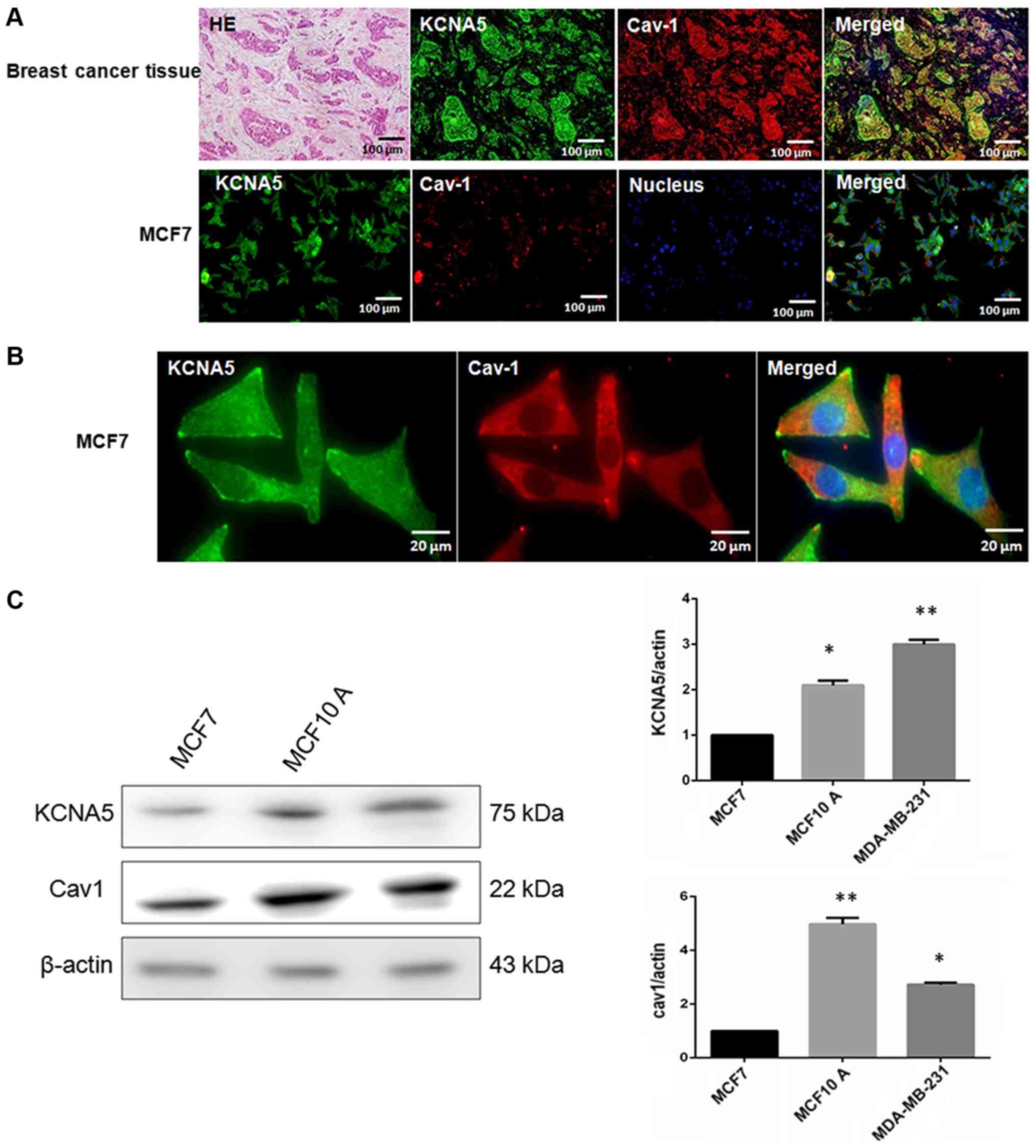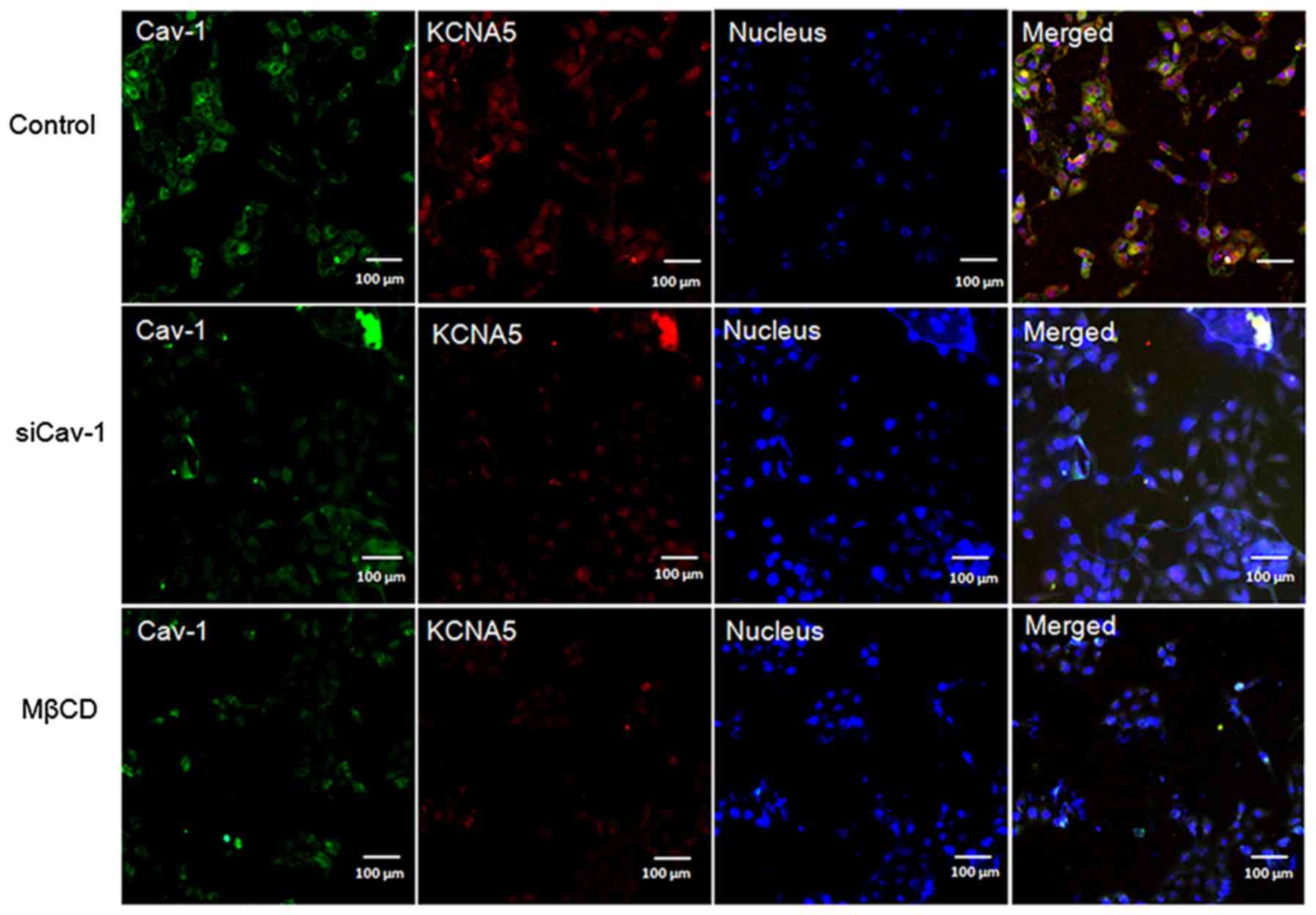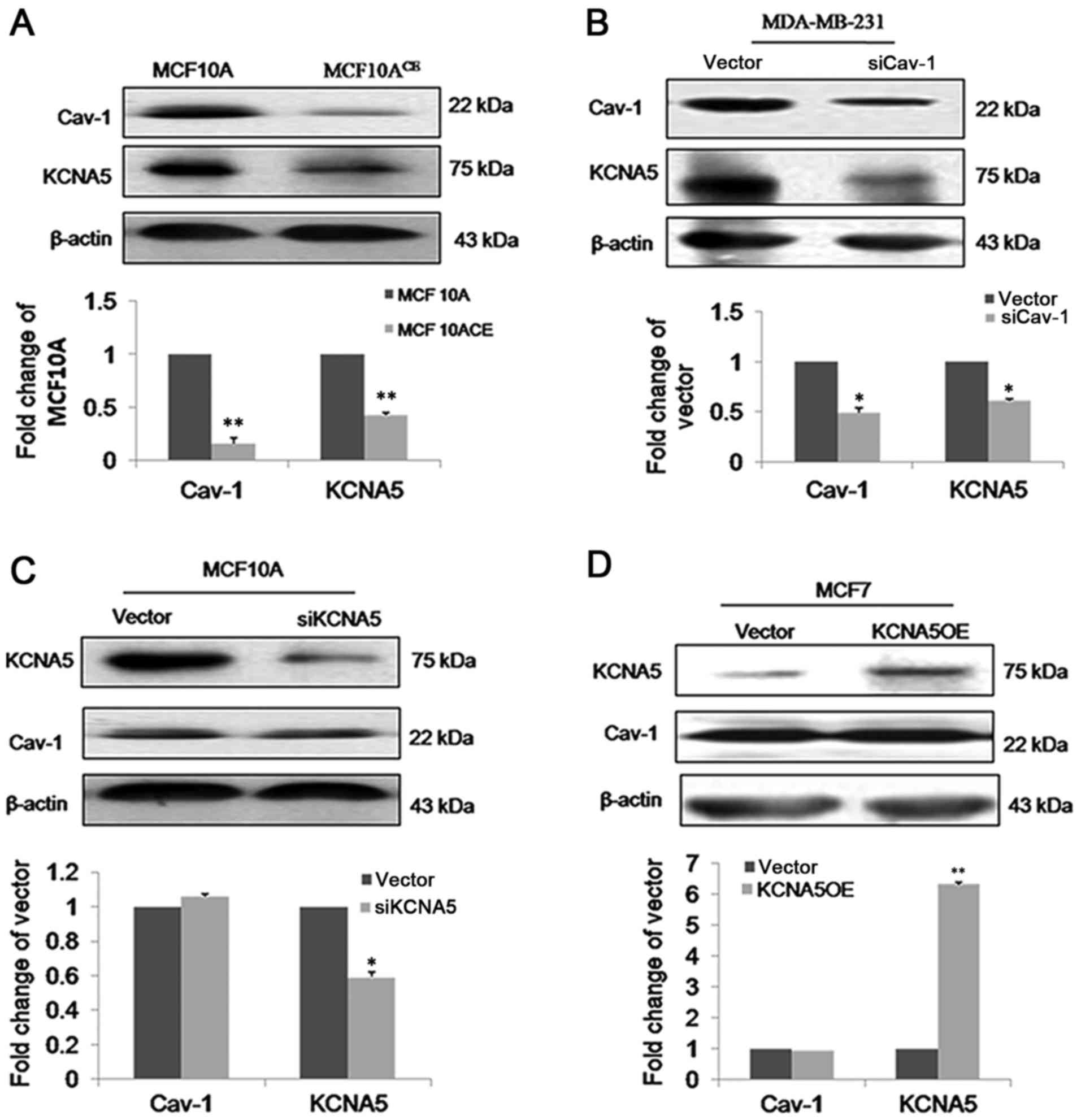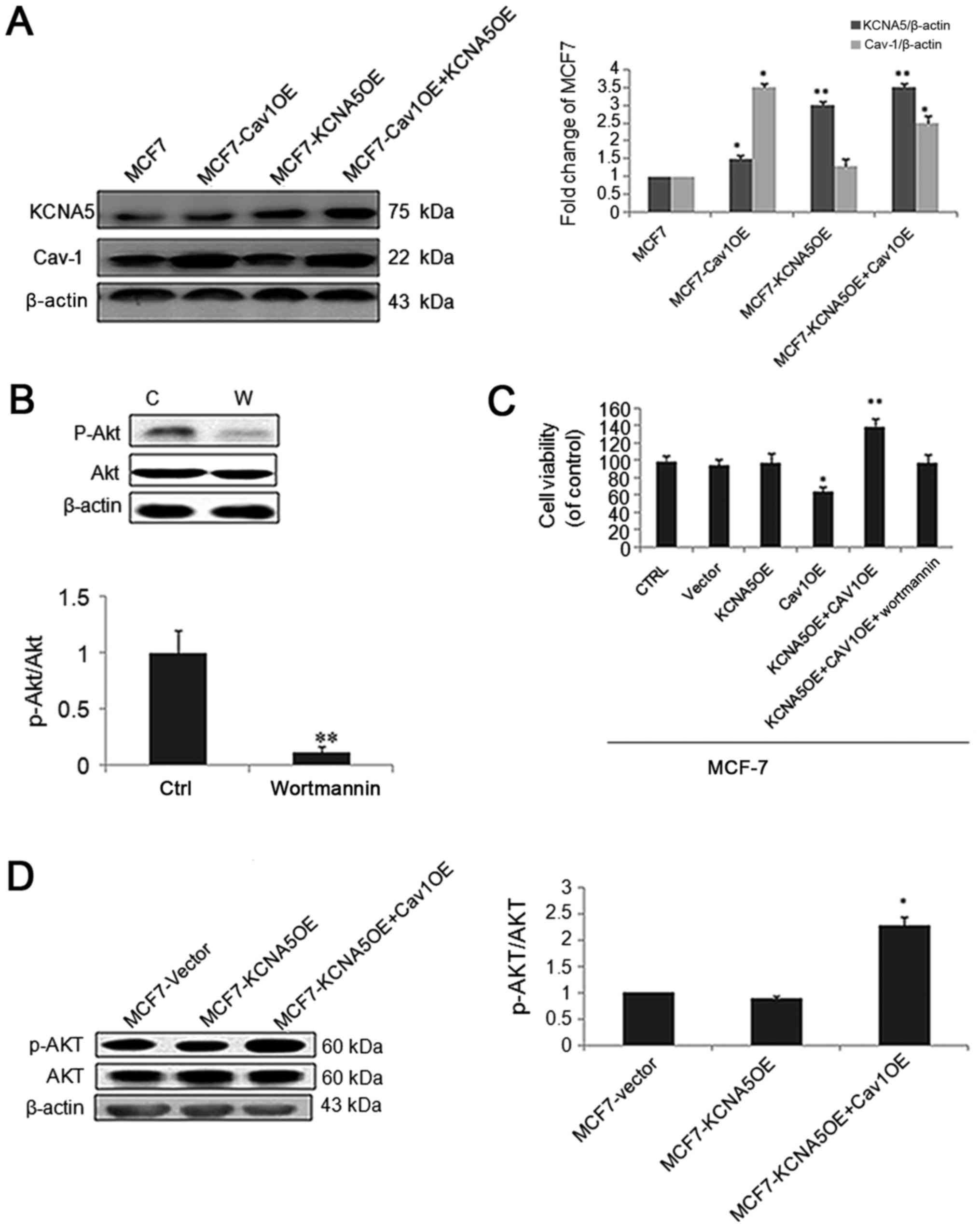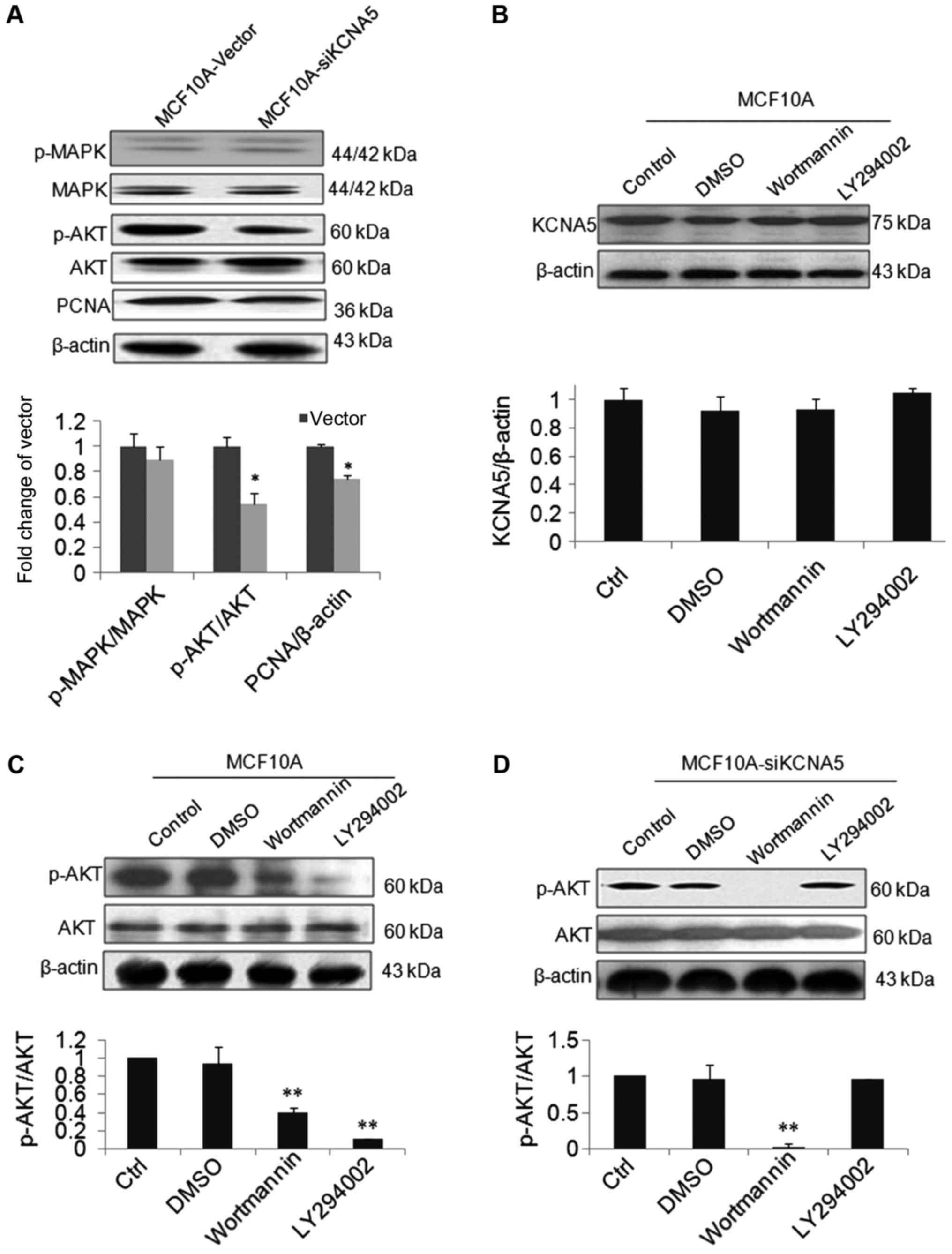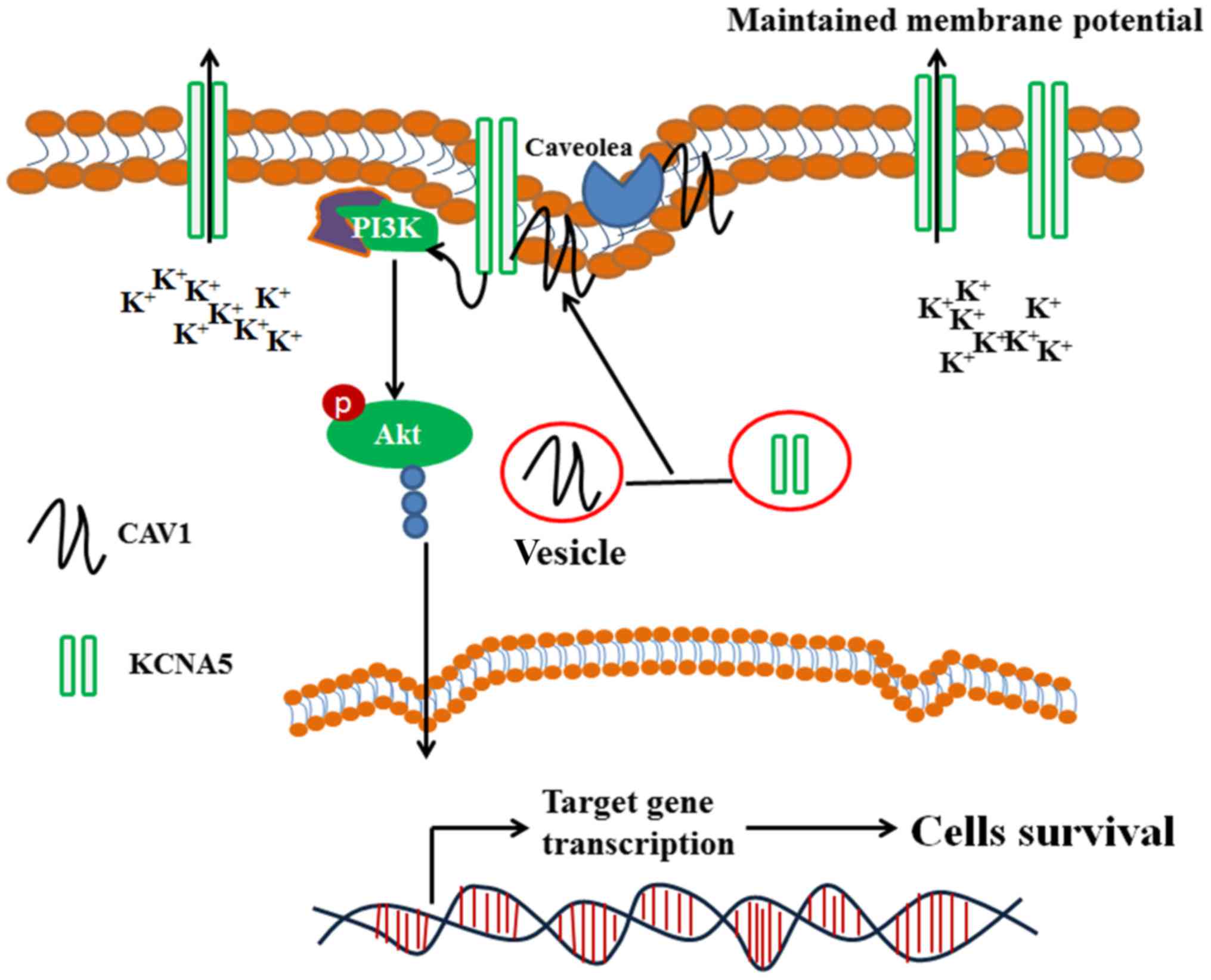|
1
|
Wulff H, Castle NA and Pardo LA:
Voltage-gated potassium channels as therapeutic targets. Nat Rev
Drug Discov. 8:982–1001. 2009. View
Article : Google Scholar : PubMed/NCBI
|
|
2
|
Kunzelmann K: Ion channels and cancer. J
Membr Biol. 205:159–173. 2005. View Article : Google Scholar : PubMed/NCBI
|
|
3
|
Lee JH, Park JW, Byun JK, Kim HK, Ryu PD,
Lee SY and Kim DY: Silencing of voltage-gated potassium channel
KV9.3 inhibits proliferation in human colon and lung carcinoma
cells. Oncotarget. 6:8132–8143. 2015.PubMed/NCBI
|
|
4
|
Delgado-Ramírez M, Morán-Zendejas R,
Aréchiga-Figueroa IA, Toro-Castillo C, Ramírez-Martínez JF and
Rodríguez-Menchaca AA: Modulation of the voltage-gated potassium
channel Kv2.1 by the anti-tumor alkylphospholipid perifosine.
Pharmacol Rep. 68:457–461. 2016. View Article : Google Scholar : PubMed/NCBI
|
|
5
|
Tegla CA, Cudrici C, Rozycka M, Soloviova
K, Ito T, Singh AK, Khan A, Azimzadeh P, Andrian-Albescu M, Khan A,
et al: C5b-9-activated, K(v)1.3 channels mediate oligodendrocyte
cell cycle activation and dedifferentiation. Exp Mol Pathol.
91:335–345. 2011. View Article : Google Scholar : PubMed/NCBI
|
|
6
|
Kazama I, Baba A, Matsubara M, Endo Y,
Toyama H and Ejima Y: Benidipine suppresses in situ proliferation
of leukocytes and slows the progression of renal fibrosis in rat
kidneys with advanced chronic renal failure. Nephron Exp Nephrol.
128:67–79. 2014. View Article : Google Scholar : PubMed/NCBI
|
|
7
|
Liu J, Feng S, Zhang L, Wu Z, Chen Q,
Cheng W, Wang SQ and Zou W: Expression and properties of potassium
channels in human mammary epithelial cell line MCF10A and its
possible role in proliferation. Sheng Li Xue Bao. 62:203–209.
2010.(In Chinese). PubMed/NCBI
|
|
8
|
Ru Q, Tian X, Wu YX, Wu RH, Pi MS and Li
CY: Voltage-gated and ATP-sensitive K+ channels are associated with
cell proliferation and tumorigenesis of human glioma. Oncol Rep.
31:842–848. 2014. View Article : Google Scholar : PubMed/NCBI
|
|
9
|
Pincus DW, DiCicco-Bloom E and Black IB:
Role of voltage-sensitive calcium channels in mitogenic stimulation
of neuroblasts. Brain Res. 553:211–214. 1991. View Article : Google Scholar : PubMed/NCBI
|
|
10
|
Wei T, Liang Z, Jin Y and Zhang L: Effect
of berberine, liensinine and neferine on HERG channel expression.
Zhongguo Zhong Yao Za Zhi. 38:239–244. 2013.(In Chinese).
PubMed/NCBI
|
|
11
|
Zhu YX, Yin H, Bruins LA, Shi CX,
Jedlowski P, Aziz M, Sereduk C, Kortuem KM, Schmidt JE, Champion M,
et al: RNA interference screening identifies lenalidomide
sensitizers in multiple myeloma, including RSK2. Blood.
125:483–491. 2015. View Article : Google Scholar : PubMed/NCBI
|
|
12
|
Guo TB, Lu J, Li T, Lu Z, Xu G, Xu M, Lu L
and Dai W: Insulin-activated, K+-channel-sensitive Akt
pathway is primary mediator of ML-1 cell proliferation. Am J
Physiol Cell Physiol. 289:C257–C263. 2005. View Article : Google Scholar : PubMed/NCBI
|
|
13
|
Roderick C, Reinach PS, Wang L and Lu L:
Modulation of rabbit corneal epithelial cell proliferation by
growth factor-regulated K(+) channel activity. J Membr Biol.
196:41–50. 2003. View Article : Google Scholar : PubMed/NCBI
|
|
14
|
Ballou LM, Lin RZ and Cohen IS: Control of
cardiac repolarization by phosphoinositide 3-kinase signaling to
ion channels. Circ Res. 116:127–137. 2015. View Article : Google Scholar : PubMed/NCBI
|
|
15
|
Shepherd AJ, Loo L and Mohapatra DP:
Chemokine co-receptor CCR5/CXCR4-dependent modulation of Kv2.1
channel confers acute neuroprotection to HIV-1 glycoprotein gp120
exposure. PLoS One. 8:e766982013. View Article : Google Scholar : PubMed/NCBI
|
|
16
|
Harder T and Simons K: Caveolae, DIGs, and
the dynamics of sphingolipid-cholesterol microdomains. Curr Opin
Cell Biol. 9:534–542. 1997. View Article : Google Scholar : PubMed/NCBI
|
|
17
|
Takaguri A, Kamato M, Satoh Y, Ohtsuki K
and Satoh K: Effect of alteration of caveolin-1 expression on
doxorubicin-induced apoptosis in H9c2 cardiac cells. Cell Biol Int.
39:1053–1060. 2015. View Article : Google Scholar : PubMed/NCBI
|
|
18
|
Banadakoppa M, Goluszko P, Liebenthal D
and Yallampalli C: Nitric oxide induces segregation of decay
accelerating factor (DAF or CD55) from the membrane lipid-rafts and
its internalization in human endometrial cells. Cell Biol Int.
36:901–907. 2012. View Article : Google Scholar : PubMed/NCBI
|
|
19
|
Takaguri A, Kamato M, Satoh Y, Ohtsuki K
and Satoh K: Effect of alteration of caveolin-1 expression on
doxorubicin-induced apoptosis in H9c2 cardiac cells. Cell Biol Int.
39:1053–1060. 2015. View Article : Google Scholar : PubMed/NCBI
|
|
20
|
Cheng ZJ, Singh RD, Marks DL and Pagano
RE: Membrane microdomains, caveolae, and caveolar endocytosis of
sphingolipids. Mol Membr Biol. 23:101–110. 2006. View Article : Google Scholar : PubMed/NCBI
|
|
21
|
Parton RG and Simons K: The multiple faces
of caveolae. Nat Rev Mol Cell Biol. 8:185–194. 2007. View Article : Google Scholar : PubMed/NCBI
|
|
22
|
Lapierre LA, Ducharme NA, Drake KR,
Goldenring JR and Kenworthy AK: Coordinated regulation of
caveolin-1 and Rab11a in apical recycling compartments of polarized
epithelial cells. Exp Cell Res. 318:103–113. 2012. View Article : Google Scholar : PubMed/NCBI
|
|
23
|
Shvets E, Ludwig A and Nichols BJ: News
from the caves: Update on the structure and function of caveolae.
Curr Opin Cell Biol. 29:99–106. 2014. View Article : Google Scholar : PubMed/NCBI
|
|
24
|
Thomas CM and Smart EJ: Caveolae structure
and function. J Cell Mol Med. 12:796–809. 2008. View Article : Google Scholar : PubMed/NCBI
|
|
25
|
Thompson MA, Prakash YS and Pabelick CM:
The role of caveolae in the pathophysiology of lung diseases.
Expert Rev Respir Med. 8:111–122. 2014. View Article : Google Scholar : PubMed/NCBI
|
|
26
|
Chaudhary KR, Cho WJ, Yang F, Samokhvalov
V, El-Sikhry HE, Daniel EE and Seubert JM: Effect of ischemia
reperfusion injury and epoxyeicosatrienoic acids on caveolin
expression in mouse myocardium. J Cardiovasc Pharmacol. 61:258–263.
2013. View Article : Google Scholar : PubMed/NCBI
|
|
27
|
Martens JR, Sakamoto N, Sullivan SA,
Grobaski TD and Tamkun MM: Isoform-specific localization of
voltage-gated K+ channels to distinct lipid raft
populations. Targeting of Kv1.5 to caveolae. J Biol Chem.
276:8409–8414. 2001. View Article : Google Scholar : PubMed/NCBI
|
|
28
|
Cogolludo A, Moreno L, Lodi F, Frazziano
G, Cobeño L, Tamargo J and Perez-Vizcaino F: Serotonin inhibits
voltage-gated K+ currents in pulmonary artery smooth
muscle cells: Role of 5-HT2A receptors, caveolin-1, and KV1.5
channel internalization. Circ Res. 98:931–938. 2006. View Article : Google Scholar : PubMed/NCBI
|
|
29
|
Brignell JL, Perry MD, Nelson CP, Willets
JM, Challiss RA and Davies NW: Steady-state modulation of
voltage-gated K+ channels in rat arterial smooth muscle
by cyclic AMP-dependent protein kinase and protein phosphatase 2B.
PLoS One. 10:e01212852015. View Article : Google Scholar : PubMed/NCBI
|
|
30
|
Brazer SC, Singh BB, Liu X, Swaim W and
Ambudkar IS: Caveolin-1 contributes to assembly of store-operated
Ca2+ influx channels by regulating plasma membrane
localization of TRPC1. J Biol Chem. 278:27208–27215. 2003.
View Article : Google Scholar : PubMed/NCBI
|
|
31
|
Anderson RG: The caveolae membrane system.
Annu Rev Biochem. 67:199–225. 1998. View Article : Google Scholar : PubMed/NCBI
|
|
32
|
Okamoto T, Schlegel A, Scherer PE and
Lisanti MP: Caveolins, a family of scaffolding proteins for
organizing ‘preassembled signaling complexes’ at the plasma
membrane. J Biol Chem. 273:5419–5422. 1998. View Article : Google Scholar : PubMed/NCBI
|
|
33
|
Overmiller AM, McGuinn KP, Roberts BJ,
Cooper F, Brennan-Crispi DM, Deguchi T, Peltonen S, Wahl JK II and
Mahoney MG: c-Src/Cav-1-dependent activation of the EGFR by Dsg2.
Oncotarget. 7:37536–37555. 2016. View Article : Google Scholar : PubMed/NCBI
|
|
34
|
Feng S, Wang Y, Wang X, Wang Z, Cui Y, Liu
J, Zhao C, Jin M and Zou W: Caveolin-1 gene silencing promotes the
activation of PI3K/AKT dependent on Eralpha36 and the
transformation of MCF10ACE. Sci China Life Sci. 53:598–605. 2010.
View Article : Google Scholar : PubMed/NCBI
|
|
35
|
Wang X, Feng S, Zhang H, Wang Y, Cui Y,
Wang Z, Liu J and Zou W: RNA inference-mediated caveolin-1
downregulation decrease estrogen receptor alpha (ERα) signaling in
human mammary epithelial cells. Mol Biol Rep. 38:761–768. 2011.
View Article : Google Scholar : PubMed/NCBI
|
|
36
|
Liu J, Qu C, Li H, Zhang Y, Sun J, Yang S,
Liu J, An L and Zou W: Expression of KCNA5 protein in human mammary
epithelial cell line associated with caveolin-1. J Membr Biol.
249:449–457. 2016. View Article : Google Scholar : PubMed/NCBI
|
|
37
|
Qu C, Fu XZ, Han C, Chen Q, Liu Y, Wang
Xb, Xi RG, Liu J and Zou W: Voltage-gated potassium channel KV1.5
protects against MPP+ mediated neurotoxicity in PC12
cells. Adv Biochem. 2:103–108. 2014. View Article : Google Scholar
|
|
38
|
Abdul M, Santo A and Hoosein N: Activity
of potassium channel-blockers in breast cancer. Anticancer Res.
23:3347–3351. 2003.PubMed/NCBI
|
|
39
|
Zou W, Zhang L, Wang X and Zhou SS: Effect
of potassium channel antagonist on proliferation in the human
mammary epithelial cells MCF10A. J Liao Ning Norm Univ. 31:23–26.
2008.
|
|
40
|
Wonderlin WF and Strobl JS: Potassium
channels, proliferation and G1 progression. J Membr Biol.
154:91–107. 1996. View Article : Google Scholar : PubMed/NCBI
|
|
41
|
El-Kholy W, Macdonald PE, Lin JH, Wang J,
Fox JM, Light PE, Wang Q, Tsushima RG and Wheeler MB: The
phosphatidylinositol 3-kinase inhibitor LY294002 potently blocks
K(V) currents via a direct mechanism. FASEB J. 17:720–722. 2003.
View Article : Google Scholar : PubMed/NCBI
|
|
42
|
Nauc V, De Lamirande E, Leclerc P and
Gagnon C: Inhibitors of phosphoinositide 3-kinase, LY294002 and
wortmannin, affect sperm capacitation and associated
phosphorylation of proteins differently: Ca2+-dependent
divergences. J Androl. 25:573–585. 2004. View Article : Google Scholar : PubMed/NCBI
|
|
43
|
Cipriani P, Di Benedetto P, Capece D,
Zazzeroni F, Liakouli V, Ruscitti P, Pantano I, Berardicurti O,
Carubbi F, Alesse E and Giacomelli R: Impaired Cav-1 expression in
SSc mesenchymal cells upregulates VEGF signaling: A link between
vascular involvement and fibrosis. Fibrogenesis Tissue Repair.
7:132014. View Article : Google Scholar : PubMed/NCBI
|
|
44
|
Sottile J and Chandler J: Fibronectin
matrix turnover occurs through a caveolin-1-dependent process. Mol
Biol Cell. 16:757–768. 2005. View Article : Google Scholar : PubMed/NCBI
|
|
45
|
Martens JR, Navarro-Polanco R, Coppock EA,
Nishiyama A, Parshley L, Grobaski TD and Tamkun MM: Differential
targeting of Shaker-like potassium channels to lipid rafts. J Biol
Chem. 275:7443–7446. 2000. View Article : Google Scholar : PubMed/NCBI
|
|
46
|
Markandeya YS, Phelan LJ, Woon MT, Keefe
AM, Reynolds CR, August BK, Hacker TA, Roth DM, Patel HH and
Balijepalli RC: Caveolin-3 overexpression attenuates cardiac
hypertrophy via inhibition of T-type Ca2+ current
modulated by protein kinase cα in cardiomyocytes. J Biol Chem.
290:22085–22100. 2015. View Article : Google Scholar : PubMed/NCBI
|
|
47
|
Schilling JM, Horikawa YT, Zemljic-Harpf
AE, Vincent KP, Tyan L, Yu JK, McCulloch AD, Balijepalli RC, Patel
HH and Roth DM: Electrophysiology and metabolism of
caveolin-3-overexpressing mice. Basic Res Cardiol. 111:282016.
View Article : Google Scholar : PubMed/NCBI
|
|
48
|
Vicente R, Villalonga N, Calvo M, Escalada
A, Solsona C, Soler C, Tamkun MM and Felipe A: Kv1.5 association
modifies Kv1.3 traffic and membrane localization. J Biol Chem.
283:8756–8764. 2008. View Article : Google Scholar : PubMed/NCBI
|
|
49
|
Pérez-Verdaguer M, Capera J,
Martínez-Mármol R, Camps M, Comes N, Tamkun MM and Felipe A:
Caveolin interaction governs Kv1.3 lipid raft targeting. Sci Rep.
6:224532016. View Article : Google Scholar : PubMed/NCBI
|
|
50
|
Zou W, Mcdaneld L and Smith LM: Caveolin 1
haploinsufficiency leads to partial transformation of human breast
epithelial cells. Anticancer Res. 23:4581–4586. 2003.PubMed/NCBI
|
|
51
|
Méndez-Bolaina E, Sánchez-González J,
Ramírez-Sánchez I, Ocharán-Hernández E, Núñez-Sánchez M,
Meaney-Mendiolea E, Meaney A, Asbun-Bojalil J, Miliar-García A,
Olivares-Corichi I and Ceballos-Reyes G: Effect of caveolin-1
scaffolding peptide and 17beta-estradiol on intracellular
Ca2+ kinetics evoked by angiotensin II in human vascular
smooth muscle cells. Am J Physiol Cell Physiol. 293:C1953–C1961.
2007. View Article : Google Scholar : PubMed/NCBI
|
|
52
|
Ishikawa T, Yuhanna IS, Umetani J, Lee WR,
Korach KS, Shaul PW and Umetani M: LXRβ/estrogen receptor-α
signaling in lipid rafts preserves endothelial integrity. J Clin
Invest. 123:3488–3497. 2013. View Article : Google Scholar : PubMed/NCBI
|
|
53
|
Abi-Char J, Maguy A, Coulombe A, Balse E,
Ratajczak P, Samuel JL, Nattel S and Hatem SN: Membrane cholesterol
modulates Kv1.5 potassium channel distribution and function in rat
cardiomyocytes. J Physiol. 582:1205–1217. 2007. View Article : Google Scholar : PubMed/NCBI
|















